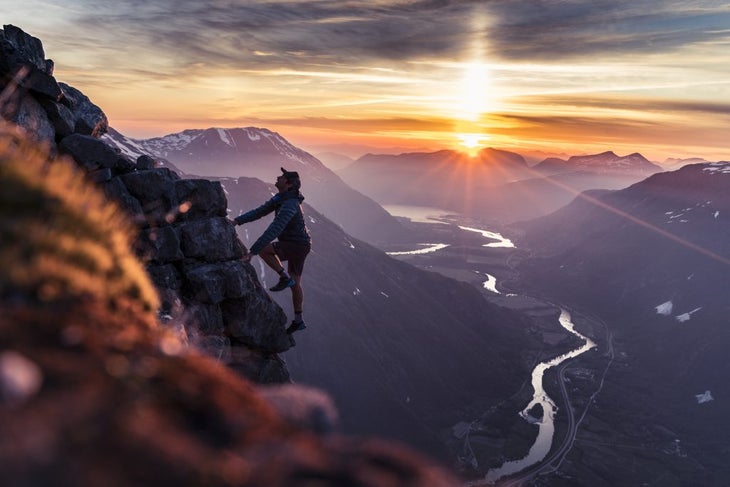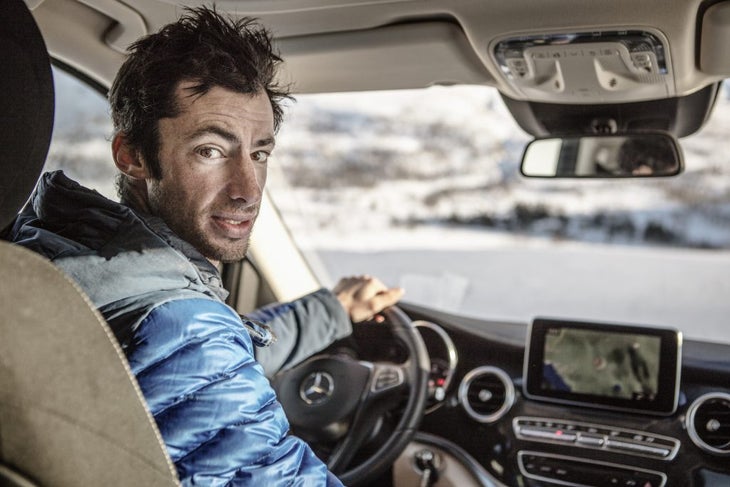New perk! Get after it with local recommendations just for you. Discover nearby events, routes out your door, and hidden gems when you sign up for the Local Running Drop.
As a trail runner and mountaineer, Kilian Jornet has set numerous records and fastest known times (FKTs) over the past 10 years. In recent years, he’s won the Western States 100, Pikes Peak Marathon, Hardrock 100 (three times) and the Ultra-Trail du Mont-Blanc (three times) while also setting records on, among others, the Matterhorn, Denali, Mt. Blanc and Mt. Everest. (In May 2017, he reached the summit of Mt. Everest alone twice in 10 days without fixed ropes or supplemental oxygen.)
We caught up with the 31-year-old Spaniard from the Catalonia region on November 9th while he was as in Denver, Colorado, to promote the U.S. launch of the “My Path to Everest” film and “Summits of My Life” book, both of which document his five-year project to establish FKTs on some of the most challenging mountains in the world using the fast-and-light way for which he is known.
In both the movie and the book, he reveals his most intimate passions, fears, contradictions and inner challenges. Jornet lives in Sweden with is life partner, Emelie Forsberg. The two are expecting their first baby in March.
Looking back, what was the most exciting aspect of summiting Mt. Everest?
KJ: “For me, the exciting thing was being at that altitude. You can be very fit, but you never know if you’ll be any good at that altitude when you’re there. I wanted to do it by carrying all of the gear and do it by myself without external help. To be able to do all of that, the question was how to acclimatize, because the more time you spend there, [the more] your fitness is going down.
If I had someone up there with oxygen I could have taken it. That would have been a compromise. It was about the experience and the challenge.
Over the past five years, I have found ways to acclimatize. The second summit was fun. It was to see how recovery works and to see if it was possible to do a big effort after a big effort at altitude.”
Some people have been critical of your speed record on Everest and a few have questioned the validity of your details. Is that troubling to you?
KJ: “It’s not troubling. For me, it was more important to have the experience I wanted with the style I wanted than to have nice pictures at the summit. Of course, we could have had cameramen all the way up and [could have had] super nice filming up there, but I wanted to climb by myself.
“If I had someone up there with oxygen I could have taken it. That would have been a compromise. It was about the experience and the challenge.”
Racing serves a different purpose now. It keeps you motivated when you are training hard.
The film represents the completion of “The Summits of My Life,” your project to achieve the fastest times on some of the world’s highest peaks. Now that it’s completed, what’s next?
KJ: “In trail running, I will still do some races. For sure, I’m not as excited about racing as I was 10 years ago but it’s always fun to do races and it keeps you in good shape. Last year, I did the Bob Graham Round in the UK and that was very fun, so I’d like to do more things like that. Here in the U.S., I would like to do linkups like Nolan’s 14ers near Leadville or the L.A. Freeway near Boulder.
“In mountaineering, [I’m interested in trying] to put together what I learned on Mt. Everest—how to be able to have a good performance at altitude and be able to acclimatize well and do it over a long distance and be able to link up summits. I don’t want to do technical climbing because I like to keep moving. But there are a lot of mountains that are intriguing to me. I definitely have some high-altitude projects in mind but I’m not sure what I want to do next. It’s a weird feeling because you feel like shit up there when you’re doing it, but when you go down after achieving a peak, you feel good about it and you appreciate what it took to do that.”

Are your days of running trail races behind you?
KJ: “My days of racing are not behind me, because I really enjoy racing. I like competition, but surely the feeling I had when I won my first Zegama-Aizkorri or my first UTMB or when I won Western States are not feelings that I can feel any more. It’s cool racing and winning races, but it’s not the same euphoria. Racing serves a different purpose now. It keeps you motivated when you are training hard. When you have a race and you know that there are young guys out there pushing themselves, you have to be in the best shape to beat them and that helps push yourself in training.
“Being able to race short and long distance, it means I need to keep overall fitness and that helps serve as a checklist to make sure my fitness is good, even when I’m also working on other projects or adventures in the mountains.”
How can recreational trail runners and climbers relate to what you do?
KJ: “What I am doing and the specifics of it are important to me but there are ways for others to relate. The details of how you do it and how you feel are only important for a few, and it doesn’t matter if the bigger population of people understand that. But I think the important things are the bigger picture ideas of having fun outside and being connected to nature.
“Whether you’re running or skiing or walking, to be outside with nature is healthy and it’s healthy for the planet for people to be doing these things because you understand what the environment is all about. And the fun thing is that you don’t need to go far away to find adventures. In everybody’s backyard, there are trails and things you can do to have adventures.”

How has trail running and ultrarunning changed in the past decade or so?
KJ: “It has changed a lot in the last 10 years. I think it’s two things: First, the community is much bigger today than it was 10 years ago. There are a lot more races and bigger races and more exposure with races. That’s especially true in Europe, where there are races with 10,000 people running. As far as competition goes, I don’t think we’re going faster than we were before but there is much more density than before. When you see the times that top runners were doing 10, 20, 30 years ago, like Matt Carpenter’s record on Pikes [Peak] or Leadville or Kenny Stuart’s record on Ben Nevis.
“It’s not that we are running faster now than we were before, but 10 years ago if you won a race, there might have been 10 minutes before second place and 10 more minutes to third place. But today if you win a race, the second-place finisher might be 30 seconds behind and then third might be 30 more seconds. So there are so many people finishing within a few minutes now and that’s great because it makes competition much more interesting.”
We’ll definitely try to share our passion for nature and for mountaineering and trail running and for being outdoors, and we hope that he or she likes that, but in the end it will be the choice of our kid.
How has the evolution of trail running gear allowed runners to run faster and achieve more FKTs?
KJ: “The gear is much more specific now than it was before. Before most brands might have had one pair of trail-running shoes. When I started with Salomon, they had a lot of hiking boots and they had a model for adventure racing and they had one model for trail running. And now they have a lot of models for long distance, for short distance, for all types of terrain and other brands are the same. And with much more specific gear, that has helped the athletes, because you can have shoes for the type of run or race you are doing or for wider feet or for much more cushioning.
“There are bigger choices for performance, but the bigger choices also help bring more people into the sport. And it goes beyond footwear, it’s clothes, hydration and watches, too. And that’s helped grow the sport while also helping improve performance.”
So you’re going to be a father! Are you more excited or nervous?
KJ: “It’s exciting and it will be challenging, too. I think there will be a lot of logistics we’ll have to adapt to because we both plan on continuing to race and to do mountain projects. So when Emelie is racing I will be babysitting and when I am racing, she will be with the baby. So I think we’ll need to organize better all of the things.”
Do you think it’s inevitable that your child will love being in the mountains?
KJ: “We’ll definitely try to share our passion for nature and for mountaineering and trail running and for being outdoors, and we hope that he or she likes that but in the end it will be the choice of our kid—we don’t know if it will be a boy or a girl yet—what he or she wants to do. It would be great if he or she follows our passion for the mountains. But who knows, our kid might be a computer geek and wants to live in a city.”
What was it like to stand on Mt. Everest?
KJ: “You don’t think much up there. For me, being on the summit was more of a relief than anything else because you are suffering going up and when you get to the top, it’s a relief knowing there’s no more uphill to go, it’s only down. But there’s not really any euphoria or adrenaline moment. You need to be really contained and you need to take away emotions, both good and bad ones because they make you make bad decisions. If you are super happy, then you maybe take it too easy and if you are in a place where you are scared, it will be the same. You need to be very rational. So the satisfaction comes more from the really hard processes than it does standing on the summit.”